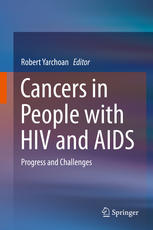

Most ebook files are in PDF format, so you can easily read them using various software such as Foxit Reader or directly on the Google Chrome browser.
Some ebook files are released by publishers in other formats such as .awz, .mobi, .epub, .fb2, etc. You may need to install specific software to read these formats on mobile/PC, such as Calibre.
Please read the tutorial at this link: https://ebookbell.com/faq
We offer FREE conversion to the popular formats you request; however, this may take some time. Therefore, right after payment, please email us, and we will try to provide the service as quickly as possible.
For some exceptional file formats or broken links (if any), please refrain from opening any disputes. Instead, email us first, and we will try to assist within a maximum of 6 hours.
EbookBell Team

4.1
20 reviewsThe association between AIDS and cancer was recognized from the beginning of the AIDS epidemic, when the appearance of Kaposi sarcoma in a cluster of young men was one of the first signs of this new disease. It was soon recognized that AIDS was caused by infection with a novel virus (HIV) and that AIDS patients are prone to develop a number of “AIDS-defining” cancers: Kaposi sarcoma, lymphoma, and cervical cancer. The development of effective combination anti-HIV therapy starting around 1996 converted AIDS from a death sentence to a manageable disease and led to dramatic shifts in the epidemic. As this therapy was able to improve immune function in patients, the incidence of most “AIDS-defining” cancers decreased. There is a misconception, however, that AIDS has gone away. In fact, as AIDS patients are living longer, the number of AIDS patients has more than doubled in the United States since 1996, and the AIDS population overall has increased in age. Also, as AIDS patients are less likely to die of other complications, cancer is coming to the forefront as one of the most common causes of death in regions where AIDS drugs are widely available. Moreover, the three “AIDS-defining” cancers are now taking a back seat to a number of other HIV-associated cancers, such as Hodgkin lymphoma, lung cancer, and anal cancer. In the developing world, AIDS-associated cancers are a major public health problem, and in some regions of sub-Saharan Africa, Kaposi sarcoma is the most common tumor in men.
In recent years, there has been a vast increase in our understanding of HIV-associated cancers. We now know, for example, that most are caused by other viruses and that the main role of HIV and immunodeficiency is to provide a supportive environment for the viruses to multiply and for the cancers to develop. But there remain a number of unanswered questions and a need for improved prevention and therapy. In the 28 chapters of this book, written by some of the most renowned experts in this field, we present up-to-date information on the cancers associated with HIV infection. The chapters cover the epidemiology of these cancers, their pathogenesis, their clinical presentation, and their treatment. The book will be of value to physicians, other medical professionals, students, and researchers with an interest in AIDS, viral-associated cancers, or HIV-associated malignancies.
TABLE OF CONTENTS
1. HIV-associated Cancers: Overview
Robert Yarchoan, Thomas Uldrick, Mark Polizotto
2. Epidemiology of AIDS-defining Malignancies
William A. Blattner and Rebecca G. Nowak
3. Epidemiology of non-AIDS Defining Malignancies
Andrew E. Grulich
4. HIV Cancers in Resource-Limited Regions
Sam M. Mbulaiteye
5. Kaposi's Sarcoma-associated Herpesvirus (KSHV)
Blossom Damania and Dirk P. Dittmer
6. Epstein Barr Virus (EBV)
Lindsey Hutt-Fletcher
7. Human Papillomavirus (HPV)
Zhi-Ming Zheng
8. Merkel Cell Polymavirus (MCV)
Nicole Fischer and Adam Grundhoff
9. Presentation and Pathogenesis of Kaposi's Sarcoma
Corey Casper
10. Management of Kaposi's Sarcoma
Susan E. Krown
11. Presentation and Pathogenesis of HIV Lymphomas
Richard F. Little, Stefania Pittaluga, Kieron Dunleavy
12. Diffuse Large B-Cell Lymphoma
Neel K. Gupta and Lawrence D. Kaplan
13. Burkitt and Burkitt-Like Lymphoma
Kishor Bhatia and Sam M. Mbulaiteye
14. Primary Effusion Lymphoma
Giovanna Tosato
15. AIDS-related Central Nervous System Lymphoma
Jan Davidson-Moncada and Thomas Uldrick
16. Plasmablastic and Other Lymphomas
Huan-You Wang, Ida Wong-Sefidan, Erin Reid
17. Hodkin Lymphoma
Michele Spina, Rosanna Ciancia, Accursio Augello
18. Multicentric Castelman Disease
Mark N. Polizzotto, Thomas S. Uldrick, Robert Yarchoan
19. Cervical Cancer
Elizabeth A. Stier
20. Anal Cancer
Joel Palefsky
21. Other HPV-Associated Cancers
Kristina R. Dahlstrom and Erich M. Sturgis
22. Lung Cancer in HIV Infection
Deepthi Mani and David M. Aboulafia
23. Hepattocellular Carcinoma in HIV-positive Patients
Massimiliano Berretta, Paolo De Paoli, Umberto Tirelli, Bruno Cacopardo
24. Merkel Cell Carcinoma and Other HIV-associated Skin Cancers
Nathalie C. Zeitouni adn Bethany Lema
25. Conjuctival Carcinoma
Kenneth O. Simbiri and Erle S. Robertson
26. Malignancies in Children with HIV Infection
D. Cristina Stefan
27. cART and Supportive Care
Ronald T. Mitsuyasu
28. Stem Cell Transplantation
Christine Durand and Richard Ambinder